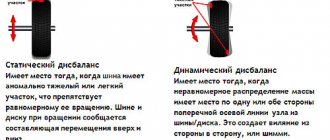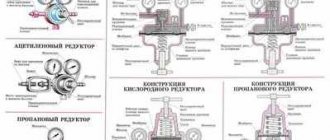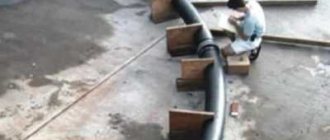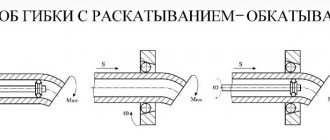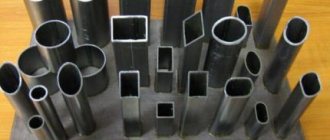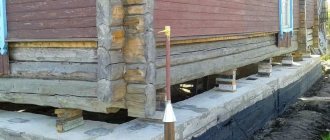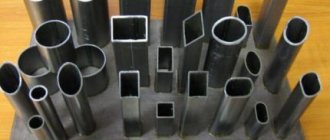I want to tell you how to straighten a HDPE pipe or vice versa - bend it to use fewer fittings. Low-density polyethylene is a fairly plastic material; pipes made from it are superior to polyvinyl chloride and polypropylene in this characteristic. However, it has a low melting point, which complicates the assembly of pipelines by welding. But when heated, such pipes easily take the desired shape, which makes it possible to do without unnecessary turning elements. And they are initially long - without unnecessary joints.
Source sovet-ingenera.com
Features of low pressure polyethylene
The polymer material has good elasticity in the operating temperature range: -20°C - +40°C. When heated to +80°C, polyethylene softens and becomes more and more viscous. The ability to resist deformation decreases. A further increase in temperature is permissible only for a short time. It should be taken into account that the technological process of forming HDPE pipes occurs at +130°C, when the raw material turns into a plastic mass. In fact, at these temperatures, their destruction occurs without any mechanical impact.
This implies the answer to the question about straightening the HDPE pipe: it is necessary to carry out its plastic deformation. The procedure at home is as follows:
- the pipe is rigidly fixed to any foundation. This can be done on any flat area of sufficient length: specially laid boards, the wall of a building, a fence, a plot of land. Wire, rope, staples, etc. can be used as fasteners. Perfect straightness cannot be achieved. However, this is not required. Even a technical HDPE pipe, used as protection for various cables, is quite suitable for drawing switching connections, despite the residual deformation;
- To remove the elasticity, a certain time will be required, during which the pipe must be in a straightened state. The duration of the process depends on a number of factors. The smaller the diameter and thickness of the walls, the faster the internal stresses will be relieved. If the procedure takes place at high temperatures, within +80°C, the pipe will straighten quickly. It is difficult to achieve such values at home. Therefore, it is necessary to rely on natural temperature. In such conditions, the process can take a whole day.
A quick way to straighten pipes
At home, the only way to speed up the straightening procedure is to heat the pipe to values close to critical. A bathhouse, a small room where you can place a heater, is quite suitable for this. If this is not the case, room temperature will be enough. The main thing is that the polymer warms up throughout its entire volume.
In conditions of absolute time shortage, the HDPE pipe can be straightened by bending it back. The procedure requires significant physical force. Therefore, it is better to use a clamp for this.
Transportation of plastic pipes is possible only in the form of coils or sections of specific sizes. When twisted, the building products resemble rings. It is known that improper handling of plastic leads to its deformation or damage.
Therefore, it is very important to understand how to straighten a plastic pipe after bending it without compromising the quality of the material
Methods and technologies for bending HDPE pipes
Low-density polyethylene at normal temperatures is a fairly plastic material. For transportation, pipes are wound into coils of various diameters, so they must first be straightened before use. Polyethylene becomes plastic when the temperature rises to 80-135°C, so it needs to be heated.
There are many ways in which you can straighten or bend a polyethylene pipe:
- using a molding machine;
- using a hair dryer;
- using a gas burner;
- using hot water.
Each of these methods has its own advantages and disadvantages, and we will describe them all below.
Using a molding machine
This is purely industrial equipment. It is usually used for bending a large number of workpieces of not very large sizes - for example, elbows. The pipe is cut into blanks, placed in a frame made of fiberboard, chipboard and other available materials with a smooth surface, inserted into a silicone shell, heated to a temperature of 80-90°C, then bent and allowed to cool.
In reality, it is impossible to use such a machine for straightening a bent pipe; it also makes no sense to purchase it for your home.
Using a construction electric hair dryer
In order to straighten a wavy pipe, you should lay it out on a flat surface, heat it with a hairdryer and stretch it. Then let it cool in a stretched, even state. This work is best done together.
To bend the pipe, it is better to make a mandrel from bars and chipboard or fiberboard. The pipe is heated with a hairdryer as evenly as possible, rotating on all sides throughout the entire bent area. Then carefully bend it, being careful not to tear it; Place in a mandrel and allow to cool.
Underheating of the workpiece will lead to its damage during deformation.
READ ALSO: After 3 years, swelling appeared on plastic pipes (photo inside)
Using a gas burner
This is the riskiest heating method. The workpiece is very easy to melt, burn, even ignite. In addition, with strong one-sided heating, the surface of the tube may foam and become smoky. When heated in this way, it is easiest to get burned.
Without some experience, you should not use a gas burner. In any case, you should practice on scraps.
The technology for bending and straightening is similar to the technology for heating with a hairdryer.
Hot liquid treatment method
This method is sometimes used in production. The coils are immersed in baths of hot water, heated, taken out, rolled out on a flat surface and stretched. Let it cool.
At home, this method is used to bend pipelines with a diameter of less than 50 mm and not too long. Using a watering can (preferably steel), several liters of hot water are poured into the pipe - 80-90°C.
It is problematic to straighten a long pipeline at home in this way - there is simply nowhere to take a large amount of slightly cooled boiling water at once.
other methods
To straighten a long section of pipe, in the summer you should use the traditional method: unwind it from the coil, lay it out and stretch it slightly (without fanaticism) in the sun, warm it up for 5-10 hours or more - the polyethylene will become more plastic. Then stretch (either with the help of an assistant, or secure the ends with clamps or some other method, and let it sit for a few more hours. In non-hot polyethylene, the process of relieving internal stress occurs slowly, and this work can take the whole day.
READ ALSO: HDPE pipe: characteristics, types and applications
To heat the bay, you can use the steam room in the bathhouse.
There is also a way to bend small workpieces using hot salt or sand. Bulk materials are heated on a tray in the oven, poured into the pipe through a steel watering can (socket), wait until the workpiece softens, and bend it using a mandrel in the same way as the previous methods.
Which way is better
The easiest way is to heat the coil in the sun and stretch it. But this doesn't always apply. For small preparations, the method of heating with water is not bad - you can determine the temperature quite accurately (a pan of boiling water with the lid open will have a temperature of approximately 85°C in five minutes. You can also measure it with a thermometer). The method of heating with sand or salt is quite acceptable - if you measure the temperature and practice in advance.
If the household has a hair dryer, then it will have to be used to straighten long sections of polyethylene pipes.
Using hot baths and a molding machine at home is not possible. Using a gas burner is unsafe and difficult - there is a high probability of damaging the pipe.
The optimal and universal way to bend or straighten a pipe made of low-density polyethylene is using a construction hair dryer. This is what we will consider.
DIY bending process
There is not always hot sun, hot water and sand, a home bath or sauna. In this case, a hair dryer will come to the rescue of the home craftsman. With its help, you can bend a short piece, you can straighten a long piece for external plumbing, or you can bend it.
Required tools and materials
To perform bending you will need:
- construction hair dryer;
- workpiece;
- mittens;
- mandrel. The mandrel is made of bars stuffed onto chipboard, OSB, fiberboard (for small diameters).
Work progress
Bending technology:
- the workpiece is heated in the area that will be bent; for uniform heating, the workpiece must be rotated;
- then you need to smoothly bend the pipe, then lay it in the frame;
- let cool, stand for a few minutes;
- then remove and let sit for at least 15 minutes.
Alignment methods
There are a sufficient number of ways to straighten a HDPE pipe with your own hands:
- Straightening in the sun.
- Heating products using hot water, hot sand or other bulk materials.
- Using a hair dryer is the most affordable method at home.
- Straightening in a special molding machine.
- Using a gas burner.
All methods are described below, you just have to choose the most suitable one.
Straightening in the sun
The easiest way to straighten a HDPE pipe is in the summer under the scorching sun, as the material becomes soft and flexible, and can be easily transformed.
- Unwind the HDPE pipe from the coil.
- Straighten and place them in open sunlight.
- Leave to heat for 10 hours until the material becomes soft.
- Then we level it and secure it with bars or any other method.
- After this, you need to let the structure cool completely; the whole procedure will take about 24 hours.
Heating with hot water
To straighten a HDPE pipe from a coil in the winter or autumn, then heating with hot water will do. This method is used in production; the coils are immersed in large containers with heated liquid, and then stretched and allowed to cool.
- At home, pipelines with a diameter of less than 50 mm are used. You also need to pour several liters of water into the pipe, and the water temperature should be about 90 degrees.
- There is also an option to level HDPE low-pressure pipes using hot sand or salt. The bulk material must be heated in the oven to a temperature of 80-90 degrees, then poured into the pipe through a steel watering can. The main thing is not to overexpose it, the sand or salt should be taken out 4 hours after falling asleep and allowed to cool.
All these methods must be carried out with special gloves to avoid burns.
A hair dryer is the most affordable method at home
It is necessary to make a frame from a sheet of fiberboard or from bars; it is better to do this together. Then follow a clear sequence:
- Heat the workpiece using a hair dryer.
- In order for the HDPE pipe to heat up evenly, you need to rotate it.
- Place the hot product on the prepared frame.
- Carefully align the pipe, secure it, and leave until it cools.
- Take out the cooled workpiece.
When heating with a hairdryer, you need to be very careful and follow the rules, because you can overheat or underheat the material, which will lead to a damaged structure.
If the device is kept far from the surface, it will not be able to heat the material. If the distance is too close, HDPE may simply melt or even ignite. Therefore, be careful.
Using a molding machine
This method is used in production when leveling a batch of small-sized pipes; purchasing a molding machine for the home is unprofitable. To avoid damaging the product, you must follow the instructions:
- It is required to make a blank from a sheet of fiberboard.
- Next, you need to make a silicone shell that will clearly secure the product, additionally protecting it from damage.
- The workpiece must be placed in a mold and screwed to the fiberboard.
- Then we insert the structure into the molding machine.
- The HDPE pipe is heated and leveled under pressure.
- All that remains is to get the cooled part.
Gas-burner
This method is similar to a hair dryer, however, it is more risky and unreliable.
- You will need to make a sheet of fiberboard on which the pipes will be located and be very careful about the distance at which you hold the gas burner. It must be kept at a distance of 30 centimeters from the surface.
- It costs about 20-25 minutes to heat the product, constantly turning it, after which it needs to be secured and allowed to cool. A plastic pipe can easily melt and be damaged.
Also, when a particular piece is heated, the surface may foam or catch fire. Therefore, it is strictly not recommended to use this straightening method without experience. However, if you decide to use a gas burner, it is better to practice on scraps first.
How to align fence posts
Is the fence lopsided or toppled? There is only one reason: an incorrectly installed foundation, incorrectly mounted pillar supports. The frame of logs and posts on which boards, metal, plastic and other materials are attached is the most important thing in a fence.
Insufficient depth, ignoring the type of soil, lack of butting - all this leads to the fact that in the end you have to think about how to level the fence posts. This article consists of two parts: in the first we will explain how to mount an initially level frame, and in the second we will tell you how to straighten lopsided supports.
How to Align Fence Posts During Construction
We specialize in metal, so we'll explain using a standard metal support pole as an example. They can be used in the construction of fences from any materials: wood, plastic, corrugated board, even brick (they are embedded in brick). You could say metal is universal.
Installing pillar supports yourself is not difficult, you just need to take into account some nuances. Firstly, it is not enough to simply drive and fill with concrete: groundwater pushes out such structures like plugs, and in the first rainy spring, the owners of the site will have to think about how to align the fence posts in height. Secondly, the standard depth of 0.7 m is not enough. It is better to dig the supports one and a half meters. More if the site is located in a windy area and the fence material is solid - high-flying.
Bending Methods
In order to give the HDPE product a configuration with the required parameters, two methods are used:
- using a special molding machine;
- using a hair dryer.
Let's look at each of these methods in a little more detail.
In industrial conditions, plastic pipes are given the desired shape using molding machines
How a HDPE pipe is bent using a forming machine
First you need to prepare the frame. This accessory will serve to protect the workpiece from damage. The frame can be made from ordinary fiberboard. But it is necessary to take into account the diameter of the pipe being bent.
Then you have to perform the following operations:
- make a silicone shell. It will perform the function of fastening and protecting the workpiece;
- insert a pipe into it and secure it in a pre-made fiberboard frame;
- fix the entire structure in the molding machine;
- then the polymer product is heated and actually bent;
- After this, you need to let the workpiece cool.
We bend HDPE pipe at home using a hair dryer
And here you first need to make a frame/template from fiberboard. But the next steps are different.
- heat the chosen place with a hair dryer;
- To ensure uniform heating, rotate the pipe slowly;
- install the softened workpiece into a pre-made molding frame;
- bend the pipe using such force that the material does not break at the point of deformation. Once the required bending angle has been created, leave the product to cool;
- remove the cooled piece.
Nails or screws placed in a semicircle on the board can be used as a bending template.
Using a hair dryer requires compliance with certain rules. In particular, when heating the workpiece, be extremely careful. A significant distance of the heat source from its surface will cause insufficient softening of the polymer, which will lead to incorrect deformation. On the other hand, exposure to high temperatures, not to mention open fire, can cause the material to ignite.
A conversation about how a plastic pipe is bent at home would be incomplete without mentioning one more method. We are talking about treatment with hot liquid. It should be said right away that this method is suitable for pipes with a diameter of less than 50 mm. For small amounts of work, a few liters of hot water will be enough to heat a small section of HDPE pipe. To avoid burns, follow safety precautions. In industry, the heating procedure is carried out in special baths. In this case, the temperature of the liquid contained there is +135˚С.
Straightening with a forming machine
Using such industrial equipment, you can quickly bend a large number of pipe blanks. This “pipe straightener” allows you to make straight pipes from coils of the required length and shape, which can be freely used in the future.
Important! When straightening with such a machine, a protective frame made of chipboard, fiberboard and other materials with a smooth surface is used, as well as silicone to create a shell.
This procedure is carried out in stages, since high temperatures can ruin the appearance and functionality of the pipe. Work process:
- A frame is created from fiberboard or chipboard according to the dimensions of the pipe.
- A silicone shell is prepared to secure and protect the pipe.
- The pipe is installed in the shell prepared for it, and it is installed in the frame.
- The resulting structure is mounted in a molding machine.
- The device heats up to 90 degrees.
- The pipe in the apparatus is subjected to pressure and straightened.
- After work, you need to turn off the machine, remove the product from the device and wait until it has cooled completely.
Straightening methods
There are several ways to straighten a HDPE pipe from a coil or after thermal deformation in order to return it to its original state on your own:
- Heating in the sun;
- Use hot water, sand or other bulk materials as a heating element;
- A hair dryer is the most affordable option;
- It is also possible to use a molding machine;
- Using a gas burner.
We will consider these methods in more detail below.
Straightening under the sun's rays
The properties of HDPE are such that under direct exposure to the sun's rays the material becomes more pliable and flexible, allowing it to easily change its shape.
The algorithm of actions is as follows:
- Unwind the required amount of HDPE pipe from the coil;
- Straighten the pipe and lay it out so that the material is constantly exposed to direct sunlight;
- Leave the pipe in this position for about 10 hours. During this time, the material will become pliable and flexible;
- After this, we straighten and securely fix the material in this position. Fixation can be carried out, for example, using bars;
- Finally, the structure must be completely cooled. This process will take at least 24 hours.
Watch the straightening process on video:
Heating with hot water or sand
If the time of year or weather conditions do not allow using the first method, then you can level the HDPE pipe using the method used in production, namely by heating with hot water. In production workshops, the entire coil is immersed in large tanks of water at the required temperature, but at home it is necessary to first cut off the sections intended for straightening.
The method is applicable only for HDPE pipes with a diameter of up to 50 mm.
Pour water heated to a temperature of 90 degrees into the pipe. It is also possible to use salt or sand. To do this, you need to heat the salt (sand) in the oven to 90 degrees. Then use a metal watering can and place the salt (sand) into the pipe
It is important to remove bulk materials in time; they should be removed after 4 hours. Heat until slightly softened. Straighten it manually and let it cool, first fixing it in the correct position. Free the section from liquid or sand.
Important! You should wear gloves with thermal protection when working, they will help avoid burns.
The most affordable option is a hair dryer
First, you need to make a frame out of fiberboard or thick plywood on which the straightening pipe will be placed. It is more convenient to carry out this operation at home with a partner. It will be needed to straighten the HDPE pipe while you perform heating. The following sequence of actions must be followed:
Heat the workpiece with a construction hairdryer; The workpiece must be constantly rotated for uniform heating; Place the product brought to the required temperature on a previously prepared frame made of fiberboard or plywood; Next, carefully shape the pipe into the desired shape, secure it in this position and leave to cool; Then take out the cooled workpiece.
It is necessary to carefully monitor the process of working with the workpiece to prevent overheating or, on the contrary, insufficient heating, since in both cases the workpiece will be damaged and the pipe will have to be repaired.
Insufficient heating will occur if the hair dryer is held too far away. If you bring the hairdryer too close, then there is a possibility of the workpiece melting or catching fire. Therefore, when working with a construction hair dryer, you should follow safety precautions.
Molding machine
- The machine is set to straightening mode;
- The pipe is placed into the mold;
- Under pressure, the pipe is aligned into the required shape;
- Then you should wait until it cools down and remove it from the molding machine.
Gas-burner
This method is related to the method described above with a hair dryer, but is more dangerous and less reliable. Required:
- Lay out the pipes on a sheet of fibreboard and hold the burner at a distance of 30 cm from the surface of the fiberboard sheet.
- Heating is carried out for 20-25 minutes, continuously rotating the heated pipe. Then you should firmly fasten the segment and wait for it to cool.
When working with a burner, there is a risk of irreversibly damaging the product. And even allow a fire. And without experience in such work, it is safer to consider other methods of straightening HDPE pipes.
Basic requirements for materials
The material that can be used when carrying out thermal insulation work must meet the following requirements:
- Have low thermal conductivity. This is the main requirement; choosing a product with a low coefficient will effectively protect the pipeline from freezing and save money.
- It is good to tolerate the effects of chemical and organic substances contained in the soil, and have biological resistance to various types of microorganisms and bacteria.
- Have a long service life without losing its physical characteristics.
- The insulation should not be afraid of exposure to moisture, absorb and allow water to pass through, its physical parameters should not change in the aquatic environment.
- Exposure to high and low temperatures, as well as their changes, should not destroy the insulator and affect its physical properties.
Bending (straightening) methods
There are several known methods for straightening coiled tubular products. Some of them are extremely simple, but are permissible only in certain climatic conditions. To implement other options, tools and materials are needed to ensure their gradual straightening. The list below lists these methods in order of increasing difficulty:
- Heating pipes from a coil under the sun in hot weather (up to 30 degrees), when the rings soften so much that they can be unwound manually and without prior preparation.
- Use a hair dryer to soften and straighten them.
- Warming up products with hot water, due to which their structure becomes plastic and susceptible to deformation.
- The use of a special molding device in the form of a stand with guide rubber rollers that allows you to level the hood from the coil.
Let's look at each of these methods in more detail.
Hot straightening
The first of these techniques is limited to ideal weather conditions and is used very rarely. When using it, you should be very careful and pull out the pipe without undue haste, so as not to damage the bend points.
In the case when a construction hair dryer is used for this purpose, you should also work with it carefully, being careful not to exceed the maximum permissible jet temperature (80 degrees). When heating with a hairdryer, you should hold it at some distance from the coil and slowly move it along the fold.
To heat HDPE products with hot water, you must first prepare boiling water and then pour it into the internal cavities of the coil. When pouring, it will cool down to about 70-80 degrees and normally warm up the folds.
Use of bench devices
The HDPE pipe can also be straightened using mechanisms specially made for this purpose.
Note! This method of arranging your pipeline is used when there is a significant length of rolled pipes and a small bend diameter. The rotating rollers on it allow, when heating the workpieces, to gently smooth out sharp bends in short areas
For ease of use, the device is placed on a trolley with rubberized wheels.
The rotating rollers on it allow, when heating the workpieces, to gently smooth out sharp bends in short areas. For ease of use, the device is placed on a trolley with rubberized wheels.
an easy way to straighten a jammed pipe
#1 amotsarack
Actually, I don’t think that I came up with something fundamentally new, but you never know it will be useful to someone. The problem was simple and trivial - the pipe on the copper radiator was jammed, so damn jammed that the hose on it was not pressed tightly and pissed from under it. Several options were brought up for discussion and considered on what to do with this; some suggested soldering, others suggested cutting and soldering a new pipe.
In the end, laziness, toad and perfectionism won. So, my humble vision of solving the problem:
1. We need a piece of water pipe Ф40 mm, with a wall thickness of 4 mm, and a length of 30 mm. We open it exactly in half lengthwise, so that the inner pipe seam is on one of the halves, ideally closer to the edge.
2. the half where there is no seam will be the outer mandrel. We are trying it on to the radiator pipe and most likely it will need to be shortened a little so that it lies exactly between the soldered seam and the terminal thickening. We shorten and chamfer with a file.
3. the second half is cut so that it is not half a circle, but somewhere around 1/3. If possible, we get rid of the piece adjacent to the seam - the iron is thicker there and bends unevenly.
4. Take a vice, clamp the smaller half with it and begin to compress it little by little so that, after removing it from the vice, it fits closely into the inner diameter of the larger half. In several passes we achieve a fit.
5. So, we have received a punch and a matrix for crimping deformations in the pipe. And we crimp them with an ordinary carpenter's clamp, only we select one where it is made of a narrow but thick U-shaped plate, and so that the thread on the screw is large. By the way, the screw should be properly lubricated before the procedure.
6. and the actual straightening. We notice where we have a dent, line the pipe from the outside and inside with our pieces of iron, and clamp it firmly with a clamp, with a fair amount of force, so that the pipe takes the desired shape. Move it a little to the side and press it again. And so we run it through all the places where it is dented. As a result, we get an absolutely even pipe, literally in 20 minutes of leisurely fiddling around with all the fittings.
Actually, that's all. No rations, no tricks. Everything is made naturally from waste, free of charge and of high quality.
I took a photo, but I’m too lazy to take them out of the pipe. If you want to see it, I'll post it. True, I didn’t photograph what the pipe was like “before”. And it had multiple deep dents along half the diameter.
How to straighten a HDPE pipe yourself
There are several such options, but first we will focus on the most budget-friendly of them. How to straighten a low-density polyethylene pipe in the hot summer? It is no secret that in the warm season, most often, utility lines for country dachas are laid. To make the pipes even, you just need to stretch them over the area, first fixing the edges. Plastic products, after lying for a short time under the burning rays of the sun, are leveled, and creases from transportation and storage completely disappear.
Naturally, no one will wait for the summer and postpone construction work on laying the pipeline for an indefinite period in order to cheaply straighten the elements included in it. What to do if it's cold outside? In this case, in order to understand how to straighten a HDPE pipe, you should resort to heat treatment of its surface.
Basically, warm water or hot air is suitable for these purposes. The pipes, as in the summer, are stretched in the garden and heat treated artificially.
If communications are of considerable length, then in such cases it is better to use a device - a trolley with an aluminum frame. This is how pipes are straightened, the diameter of which varies from 14 to 20 mm. With the help of rotating rollers, you can eliminate kinks, and thanks to rubberized wheels, you can ensure ease of transportation.
If the workpiece is short, then specific areas must be heated.
When choosing equipment, pay attention to:
- the presence of several modes of its operation;
- possibility of thermal regulation and air flow control.
Having understood the equipment and understood how to straighten a polyethylene pipe from a coil, you will completely abandon the use of fittings, and your HDPE pipes will take the shape required on the farm.
Common mistakes
The main mistake is overheating the workpiece or insufficient heating. In the first case, the polyethylene will begin to melt (the melting point of HDPE is only 107°C), in the second, the inner layer will not warm up, and the polyethylene will be brittle and burst when bent. If overheated, the workpiece will be too plastic and, when cooled, will have insufficient strength.
Our video will help you understand the intricacies of installing low-density polyethylene products:
A polyethylene pipe with a diameter of up to 90 mm should be bent in no more than forty seconds.
When heated with a gas burner, there is a high probability of ignition of the polymer.
It is undesirable to bend the workpiece at an angle greater than 90 degrees - there is a high probability of damage to the bend.
The minimum bending radius when bending in a hot state must be at least three outer diameters.
"Folk" way
At home, without having either a hairdryer or boiling water on hand, pipes made under low pressure can be straightened by placing a heated bulk substance in them.
To implement this method, you will need to perform the following operations:
- First, a sand or salt mixture of the required condition is prepared.
- Then it is poured into a rag bag and placed in an oven with air temperature controlled (it should not exceed 100 degrees).
- After heating, the mixture is poured into the bend of the pipe blank and left there for a while, after which it can be straightened.
Additional Information! At the dacha, instead of an oven, you can take any suitable baking sheet used for cooking over an open fire.
To fill the hot mixture, it is recommended to use a special ceramic scoop with a metal funnel, which ensures the convenience of all operations.
In conclusion, we note that when choosing a suitable method for leveling HDPE pipes, preference is given to the option in which the impact on the structure of the material is minimal. This approach is very important for work, since these products will have a long time of operation as part of a pipeline assembled with your own hands.
How to bend plastic at home
Now we will pay special attention to the issues of bending and straightening PVC products. Most craftsmen do not use auxiliary equipment at home. To bend products made of polyvinyl chloride, a sand/salt mass of bulk material is heated in a heat-resistant cabinet. Also, experts, in addition to a hot oven, use a baking sheet. Having heated the bulk mass to a certain temperature, it is poured into the PVC product using a scoop and a construction funnel. It must be remembered that only metal funnels and barrier lids are useful for these purposes.
An important role in solving the problem of how to deform a PVC pipe at home is played by calculating the required temperature of the bulk material. As stated above, it should not be more than +80˚С, because from this point PVC begins to turn into a soft substance. Taking useful information from specialized literature, it is not difficult to understand how to align a HDPE pipe. The most important thing is that the temperature of the bulk product should not exceed or be below the standard limit.
Bending plastic at home includes the following steps:
- Well-heated sand or salt should be poured into a pipe, onto which a barrier cap must be placed on one side in advance.
- After a few minutes, you can begin the bending procedure. The waiting time for a pipe to heat up is directly dependent on the thickness of the PVC pipe walls: thin-walled products heat up much faster than thick-walled ones. This procedure should be performed without much effort.
- After this, the workpiece needs to be cooled by placing it under a cold stream of tap water. Due to the increased heat capacity of sand and salt, the cooling process can last up to 10 minutes.
- Then shake out the bulk substances from the cooled pipe and rinse the internal cavity of the product thoroughly with clean water.
This method is also suitable for bending PVC products at right angles. At the bending point, the cross-section should still be circular.
Please note: cold products made from polyvinyl chloride are completely harmless to humans. But PVC is recognized as a carcinogen, therefore, when working with heated pipes made of this material, it is better to wear a respirator and ventilate the room well.
Naturally, by using the loose mass, you can straighten previously bent polyvinyl chloride products at home. The requirements for performing the procedure are completely simple, so any amateur can figure out how to straighten a polyethylene pipe without the use of auxiliary equipment.
Technologies for bending polyethylene products
All known methods of changing the shape of such pipes are based on the main properties of the material from which they are made. The polymer softens under the influence of strong heat and can take the shape we need. This can be done using heating devices:
- Construction electric hair dryer; Special molding machine.
Some craftsmen create homemade devices in the form of a spiral of copper wire, with the help of which they can also achieve deformation of the material. A special tool is also used to cut workpieces to the required length.
Chipguru
- Forum Forum Rules
- Rules for Editors
- Competition rules
- Flea Marketer's Guide
- Educational program on the forum Change the color of the forum
- How to insert photos
- How to insert links
- How to embed a video
- How to indicate offtopic
- How to quote
- Stitching messages
- Theme icons
- Subscribe to topics
- Auto-subscribe to topics
- Metal
- Bearings
- Steel grades and alloys
- Thread diameters
- Links
- Unanswered topics
- Active topics
- Search
- our team
How and why pipes are bent
Pipe bending technology is based on the properties of the polymer to take any shape under the influence of high temperatures.
It is necessary to bend the pipe and to give the desired bend shape when installing a pipeline, which can have a different configuration, so as not to use additional connecting parts, you can simply give the pipe the desired shape using its technical properties.
This is achieved using special heating equipment in the form of a molding machine, a hair dryer or a gas burner:
The operating principle of the molding machine is to use a special frame made of wood board, into which a pipe is fixed, placed in a silicone shell created by the machine. When heated, the pipe takes on the shape of a frame. It is cooled for 10 minutes and then taken out and left to cool completely.
Expert advice
Don’t forget about safety precautions - gloves, and when working with a burner, a tarpaulin suit is required! Beware of burns.
After cooling, you should let the polyethylene sit for a few more minutes to release the internal stresses in the plastic.
To straighten a long pipe, it is not necessary to heat it completely; it is enough to heat only a few sections.
Low-density polyethylene is afraid of ultraviolet radiation - it is usually laid underground, in dark basement floors. Where there is ultraviolet radiation, polypropylene pipes or polyvinyl chloride are used.
If bending is unsuccessful - for example, the wrong angle is obtained - the polyethylene can be reheated and bent only after it has completely cooled, otherwise the polymer will be brittle.
When installing HDPE pipes, soldering is not used - they are mounted using special clamp fittings.
Features of low pressure polyethylene
Low-density polyethylene is a high-density polymer that is produced by polymerizing ethylene under low pressure conditions. It has low thermal conductivity, excellent wear resistance and sufficient tensile and compressive strength. Remains neutral in relation to aggressive chemical environments, does not crack or collapse at temperatures from -60°C to + 60°C. It is characterized by vapor and liquid impermeability. It can be corrugated. Products made from it have a service life of about 50 years. The material is non-toxic and environmentally friendly, resistant to greasy substances.
HDPE is produced using three technologies (depending on the choice of the manufacturer):
- Suspension polymerization. In this case, granules are used as raw materials, which are exposed to a suspension with chemical stabilizers. The mixture is constantly stirred, which creates the condition for the stable fusion of all components and maximum homogeneity of the material without defects.
- Solution polymerization. The process takes place at a temperature of 600C-1300C using a catalyst, which also ensures a high degree of homogeneity of the mass, which results in a flexible material that is easily restored after deformation.
- Gas-phase polymerization. This technology is almost never used at present, since the result is not of high quality. Its principle is that monomers polymerize in a gaseous environment. The structure of the material is not uniform, and its wear resistance leaves much to be desired.
High-quality low-density polyethylene is characterized by reliable intermolecular bonds with low branching, therefore it is characterized by high tensile strength
It is important that no precautions are required when working with it. Although, during production, as a result of reactions between the elements of the compositions, waste is generated that is harmful to the environment, and therefore must be properly disposed of in accordance with industry standards. Disposal of a used polymer product consists of simply melting it into recycled materials and is carried out without the need for additional components and complex technologies
Disposal of a used polymer product consists of simply melting it into recycled materials and is done without the need for additional components and complex technologies.
According to GOST 16338-85, which is currently in force without changes since its approval in 1985 and meets international requirements, HDPE must have a density of at least 0.93 g/cm3, a melting point of 1250C -1300C, and resistance to bending failure not should be less than 19 MPa, resistance to cut destruction - not less than 19 MPa, water absorption per month should not exceed 0.04%.
READ ALSO: How to Connect a Circulation Pump into a Polypropylene Pipe
Allowable bending radius
As we wrote above, HDPE pipe can be sold on reels, therefore, it is flexible, capable of taking different shapes
To deform it, for example, to route the system around obstacles, it is not necessary to use special equipment, but it is important to know the basic requirements and limitations. One of these conditions is the permissible bending radius indicator
Since this type of polyethylene is characterized by elasticity and at the same time retains strength, it is possible to create different pipeline configurations, adhering to the recommended minimum bend radius values. The indicator depends on the SDR and installation temperature, since thermal expansion leads to a change in the size of the system. There are special tables in which the maximum bending of HDPE pipes is calculated taking into account the described conditions.
If there is a need to create a perfectly right angle, it is recommended to use a template. It is necessary to gradually warm up the bend area, the length of which should be six of its diameters. If this condition is not met, then bending the HDPE pipe by 90 degrees can disrupt the structure of the material, which will lead to premature wear of the system and its defects.
